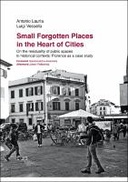Explore

Small Forgotten Places in the Hearth of Cities
Antonio Laurìa and LUIGI VESSELLA
2021
0 Ungluers have
Faved this Work
Login to Fave
This book is the result of a research project designed and carried out at the Department of Architecture, University of Florence. This book discusses urban public spaces and, more specifically, run-down, inactive micro-spaces that are barely used due to their location, dimensions, morphology or semantic characteristics. In literature, these spaces are often defined as “residual urban spaces.” A large abandoned industrial area on the outskirts of a town or a small interstitial space in a historical centre can be residual. With respect to such a broad subject matter, the book seeks to radically limit the field, concentrating on public residual spaces found in the oldest parts of cities. The book reflects on this theme and introduces a method for reading and assessment of the residuality of public spaces in historical contexts (Residuality Assessment Process) which was tested in the historical centre of Florence. It is the authors’ view that residual spaces, above all if designed according to a system logic, can go from being problems to potential activators of urban and social regeneration processes, offering a useful contribution to improve city life.
This book is included in DOAB.
Why read this book? Have your say.
You must be logged in to comment.
Rights Information
Are you the author or publisher of this work? If so, you can claim it as yours by registering as an Unglue.it rights holder.Downloads
This work has been downloaded 31 times via unglue.it ebook links.
- 31 - pdf (CC BY) at OAPEN Library.
Keywords
- Architecture
- inactive micro-spaces
- Other technologies & applied sciences
- regeneration processes
- residual urban spaces
- run-down
- Technology, engineering, agriculture
- Technology: general issues
- The arts
- urban public spaces
Links
DOI: 10.36253/978-88-5518-497-7Editions

